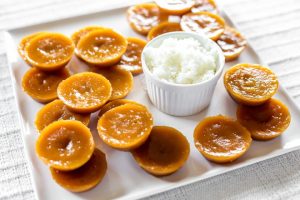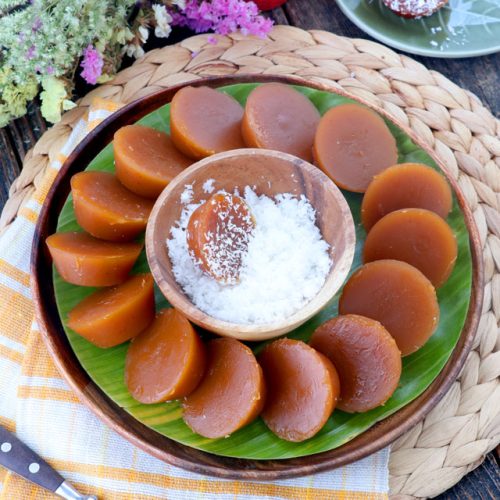Kutsinta (cuchinta) are Filipino steamed cakes made with flour, tapioca flour, and brown sugar. Soft, chewy and topped with grated coconut, they’re a delicious breakfast, snack or dessert.you can prepare it ahead for hole familly and specially kids. this rice cake is one of the most popular rice cakes in the Philippines and every morning almost all Filipinos have a chance of having one of this, the walking street vendors that strolls in the streets early morning on villages with their hand horn tirelessly sell these on a daily basis alongside puto.
Kutsinta comes from the Chinese word ‘Kueh Tsin Tao’ where ‘Kueh’ in Hokkien language means a cake, bite-sized snack or dessert foods. If you are Malaysian, Singaporean or Indonesian I guess you can relate as Kueh or Kuih are these various rice cakes popular within the region. It was believed that the Hokkien Chinese brought this over to Philippines during the 9th century when the Chinese started trading with the Philippines. Coconut was added later on as a Filipino adaptation to give it more flavour and texture.
Back home we barely make them as they are available almost every day right at your doorstep, it is also so affordable so there was no point making them at home. Today I live outside of the Philippines so making them is our only option, luckily this is also one of the easiest rice cakes to make.
What lye water does in kutsinta :
Food grade Lye water is a strong alkaline solution used in various cooking processes such as curing and baking. As a key ingredient in making kutsinta or pichi-pichi as well in Chinese moon cakes, bagels, pretzels, and ramen noodles, it raises the ph level of the dough for a richer color and a springy texture.
What is it made of?
While I was searching the net, I found that there are 2 different kinds of kutsinta recipe. One uses a mix of glutinous rice flour and sweet rice flour. The other uses a mix of all-purpose-flour and tapioca flour. I liked the texture of the latter much better, holds its shape better but still soft and chewy.I’ve been meaning to make kutsinta for quite a while now. Well actually, I did try it once. I did not have lye water at the time and used the alternative. However, they turned out to be too sticky and soft. It was so bad, I had to throw them all away.
Cooking tips :
- The atsuete is primarily added to deepen the color and you can use more or less depending on the brown sugar you use.
- I use silicone molds for steaming; if you’re using tin molds, you might need to lightly grease the inside for easy removal of the steamed cakes.
- Steam in a gentle simmer to prevent the kutsinta from sinking in the middle.
- These are mini-sized cuchinta; recipe yield depends on the size of molds you use.
- Make sure to stir the mixture in between pouring into the molds as the flour tends to settle in the bottom.
How to serve :
- These steamed rice cakes are traditionally served for breakfast, midday snack or after-meal dessert.
- To store, transfer to a container with a tight-fitting lid and refrigerate for up to 3 days. For longer life, top with coconut when ready to serve
padcook suggest to you two ways for making this wonderfoul Filipino steamed cakes :
Old Fashioned Kutsinta Recipe !!
Kutsinta is a popular Filipino snack made with glutinous rice flour, lye water and other ingredients topped with grated coconut.Ingrédients
First way Ingredients :
- ¼ cup glutinous rice flour
- ¾ cup all purpose flour
- 2 teaspoons lye water
- ¾ cup brown sugar
- 1½ cup water
- 1 teaspoon powdered achiote dissolved in 2 teaspoon of water, take the water from the 1 ½ cup water this recipe calls for or use 2 teaspoons of annatto seeds dissolved in 2 tablespoons of water
- vegetable oil to coat mold
- grated coconut for topping
Second way Ingredients :
- 1 1/2 cups flour
- 1/2 cup tapioca flour
- 1 1/2 cups dark brown sugar
- 3 cups water
- 3 cups water
- 1 tablespoon lye water
- grated coconut for topping
Instructions
Instrutions of the First way :
Instrutions of the Second way :
Notes
If using desiccated coconut: In a bowl, add about a quarter cup of water to half a cup of desiccated coconut and mix really well. Make it ahead of time, like 30 minutes earlier so it can sit for a couple of minutes to absorb the liquid, make sure to mix from time to time. Adjust the measurements as needed. If you need to make more kutsinta, triple the amount of this recipe. The ratio of all-purpose-flour to tapioca flour is 3:1 About LYE Water. It is known as Lihiya in Filipino. if you like it softer or less firm then reduce the amount to ½ teaspoon.
Old Fashioned Kutsinta Recipe !!!
previous post


